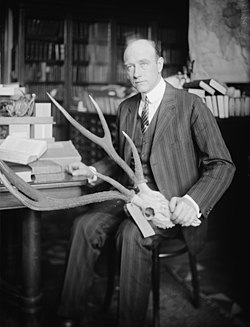Roy Andrews
| Roy Chapman Andrews | |
|---|---|

Roy Chapman Andrews
|
|
| Born |
Roy Chapman Andrews January 26, 1884 Beloit, Wisconsin, U.S. |
| Died | March 11, 1960 (aged 76) Carmel-by-the-Sea, California, U.S. |
| Resting place | Oakwood Cemetery, Beloit, Wisconsin, U.S. |
| Nationality | American |
| Occupation | Explorer, adventurer, naturalist |
| Years active | 1909–1960 |
| Employer | American Museum of Natural History |
| Known for | Paleontological field work |
| Home town | Beloit, Wisconsin, U.S. |
| Spouse(s) | Yvette Borup, Wilhelmina Christmas |
| Awards |
Hubbard Medal (1931) Charles P. Daly Medal (1935) Vega Medal (1937) Cover of Time Magazine, October 29, 1923 |
Roy Chapman Andrews (January 26, 1884 – March 11, 1960) was an American explorer, adventurer and naturalist who became the director of the American Museum of Natural History. He is primarily known for leading a series of expeditions through the politically disturbed China of the early 20th century into the Gobi Desert and Mongolia. The expeditions made important discoveries and brought the first-known fossil dinosaur eggs to the museum. His popular writings about his adventures made him famous.
Andrews was born on January 26, 1884, in Beloit, Wisconsin. As a child, he explored forests, fields, and waters nearby, developing marksmanship skills. He taught himself taxidermy and used funds from this hobby to pay tuition to Beloit College. After graduating, Andrews applied for work at the American Museum of Natural History in New York City. He so much wanted to work there that after being told that there were no openings at his level, Andrews accepted a job as a janitor in the taxidermy department and began collecting specimens for the museum. During the next few years, he worked and studied simultaneously, earning a Master of Arts degree in mammalogy from Columbia University. Andrews joined the Explorers Club in New York during 1908, four years after its founding.
From 1909 to 1910, Andrews sailed on the USS Albatross to the East Indies, collecting snakes and lizards and observing marine mammals. In 1913, he sailed aboard the schooner Adventuress with owner John Borden to the Arctic. They were hoping to obtain a bowhead whale specimen for the American Museum of Natural History. On this expedition, he filmed some of the best footage of seals ever seen, though did not succeed in acquiring a whale specimen.
...
Wikipedia
